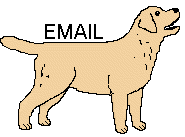 Click here to go to J-B Wholesale Pet Supply to order your crate
Click here to go to J-B Wholesale Pet Supply to order your crate
A crate is a portable "kennel" that is used to train a young puppy or safely transport your dog in a plane or car. It can also be used as a "home" for your dog when you travel, making your dog a welcome visitor in a friend's home or motel.
A crate can be plastic or metal. The plastic crate is used a lot for air travel and is enclosed except for the door and a small grate on each side. The metal crates are more open, and some are made to fold down which makes them very easy to transport.
Dogs are den animals who seek small, cavelike enclosures to crawl into. Most puppies will look for a place to go to sleep that is a tight fit, like under the coffee table. With the crate, you are supplying a perfectly safe environment for your puppy. It is a safe haven away from underfoot and small children, and it is a private bedroom which it will not soil if it can help it. Using a crate can alleviate numerous problems, can stop other problems from starting, and can housebreak a puppy with ease.
The crate should be in a "people" area, the kitchen or family room. The crate should be within easy reach during the day, so that when things get busy and you can't watch the puppy, the crate is handy, not in the basement or on another floor. If you need two crates in different parts of the house, get two. Dogs are social animals and if you lock a puppy away where they can't see what's going on, you will have a harder time getting the puppy to adjust to a crate.
Set up a routine that works for you and the puppy. First thing in the morning let the puppy out to potty. If you want them to eliminate in a certain area, take them there and praise them when they go. Also, a catch phrase like "go now" or "hurry up," if said every time, will help your puppy learn faster. The puppy should take all naps in the crate it will make nightime easier as the puppy adjusts to being confined. When the puppy is loose in the house it should be confined to the room you are in with a babygate. If you can't be with the puppy, use the crate. If the crate is properly introduced, the dog will grow to think of the crate as its den. Most dogs that are crate trained will use the open crate as a resting place.
The major use of the crate is to prevent the dog from doing something wrong. House manners are just as important as house breaking. It is useless to correct a dog for something that it did 5 minutes ago; you must catch them in the act. If the dog is out of the crate unsupervised, it may do something wrong and not be corrected, or worse, corrected after the fact. If the dog is not corrected, it may develop problem behavior as a habit or learn that it can get "away with it" when it is not supervised.
The dog will not associate a correction with a behavior unless given at the time of the misbehavior. Corrections after the fact will only confuse the dog and lead to a lack of trust from your dog. If you find evidence of a misdeed after the fact, understand it is your fault, not the dog's. If you use your crate as you would a child's playpen, to keep the puppy safe when you cannot watch it closely, the results will be amazing.
The crate is a tool; it should be used for at least a year with a puppy. A very young dog should be placed in its crate whenever it cannot be supervised. As the dog gets older, more freedom can be allowed, but not hours at a time. If you leave the house, the dog should be in its crate (also when you are sleeping). Most people make the mistake of allowing the dog too much freedom too soon. This only leads to destructive behavior in the teenage dog. When they are trustworthy while you are home but not within sight, then you can start leaving them alone for very short periods, while you run to the corner store or post office. If all is fine at home when you return, greet the dog normally. Some dogs have separation anxiety when left; coming and going should be no big deal, no big scenes which will leave the dog confused. After the dog has proven himself to be trustworthy, leave the dog for longer periods of time. But the crate should be left for times you need the dog out of the way, or for the dog to go to when they want to rest.
 Click here to go to J-B Wholesale Pet Supply to order your crate
Click here to go to J-B Wholesale Pet Supply to order your crate
 Recommended Reading
Recommended Reading